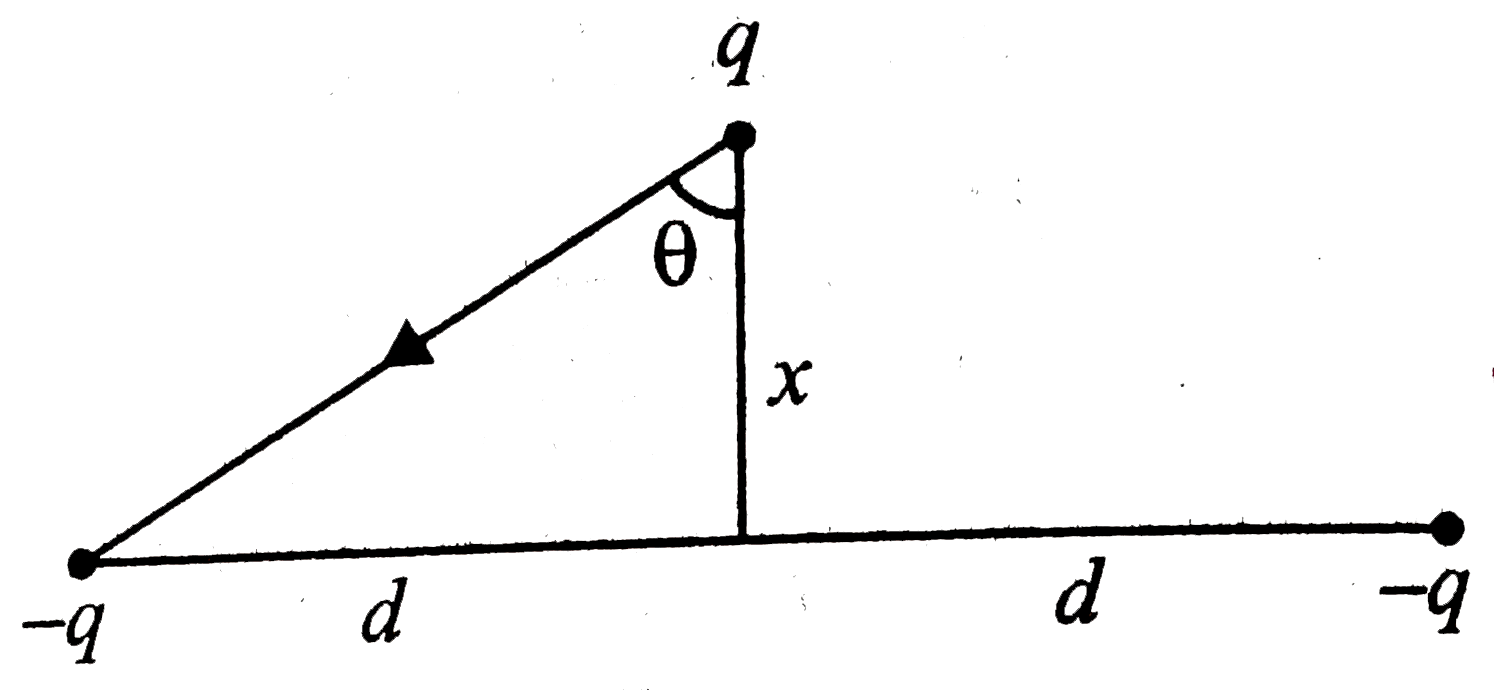Two charges +Q each are fixed at points C and D. Line AB is the bisector line of CD. A third charge +q is moves from A to B, then from B to C

From A to B electrostatic potential energy wil decrese
from A to B electrostastic potential ennergy wil increase
From B to C electrostatic potential energy will increase
From B to C electrostatic potential energy will decrease
The correct Answer is:B, C
Along the line AB charge q is at unstable equililbrium position at B (when displaced from B along AB net force on it is away from B, whereas force at B is zero). Hence potential energy at B is maximum.
Along CD equilibrium of q is stable. Hence, potential energy at B is minimum along CD.
Topper's Solved these Questions
- ELECTROSTATICSBOOK - DC PANDEY ENGLISHCHAPTER - ELECTROSTATICSEXERCISE - Exercise 24.1
4 Videos
- ELECTROSTATICSBOOK - DC PANDEY ENGLISHCHAPTER - ELECTROSTATICSEXERCISE - Exercise 24.2
9 Videos
- ELECTROSTATICSBOOK - DC PANDEY ENGLISHCHAPTER - ELECTROSTATICSEXERCISE - Example Type 8
3 Videos
- ELECTROSTATIC POTENTIAL AND CAPACITORSBOOK - DC PANDEY ENGLISHCHAPTER - ELECTROSTATIC POTENTIAL AND CAPACITORSEXERCISE - (C) Chapter exercises
50 Videos
- GRAVITATIONBOOK - DC PANDEY ENGLISHCHAPTER - GRAVITATIONEXERCISE - All Questions
135 Videos
Similar Questions
Assertion: Two charges −q each are fixed points A and B. When a third chrge −q is moves from A to B, electrical potential energy first decreases than increases,

Reason: Along the line joining A and B, third charge is stable equilibrium position at centre.
View SolutionTwo charge +aq and -q are kept apart. Then , at any point on the right bisector of line joining the two charge
View SolutionA two point charges 4q and -q are fixed on the x - axis x=−d2andx=d2 , respectively. If a third point charge 'q' is taken from the origin to x = d along the semicircle as shown in the figure, the energy of the charge will

View SolutionA positive charge +Q is fixed at a point A. Another positively charged particle of mass m and charge +q is projected from a point B with velocity u as shown in (Fig. 3.103). Point B is at a large distance from A and at distance d from the line A C. The initial velocity is parallel to the line A C. The point C is at a very large distance from A. Find the minimum distance (in meter) of +q from +Q during the motion. Take Qq=4πε0mu2d and d(√2−1)m.
 .
.
View SolutionTwo equal positive charges Q are fixed at points (a, 0) and (−a,0) on the x-axis. An opposite charge -q at rest is relased from point (0, a) on the y-axis. The charge -q will
View SolutionA charge (−q) and another charge (Q) are kept at two points AandB respectively. Keeping the charge (+Q) fixed at B, the charge (−q) at A is moved to another point C such that ABC forms an equilateral triangle of side l. The net work done in moving teh charge (−q) is
View SolutionTwo equal negative charges −q are fixed at points (0,−a) and (0,a) on y-axis. A poistive charge Q is released from rest at point (2a,0) on the x-axis. The charge Q will
View SolutionTwo charges −q each are fixed separated by distance 2d. A third charge q of mass m placed at the mid-point is displaced slightly by x(x<<d) perpendicular to the line joining the two fixed charges as shown in Fig. Show that q will perform simple harmonic oscillation of time period.
T=[8π3∈0md3q2]1/2

View SolutionThere is a fixed positive charges Q at O, and A and B are points equidistant from O. A positive charge +q is taken slowly by an external agent from A to B along the line AC and then along the line CB.

View SolutionTwo chargess +q and +2q , are held in place on the x axis at the locations x=−d and x=+d respectively. A third charge, +3q , is released from rest on the y axis at y=d. (a) Find the electric potential at the initial location of the third charge. (b) Find the initial electric potential energy of the third charge. (c) What is the kinetic energy of the third charge when it has moved infinity far away from the other two charges ?
View Solution
